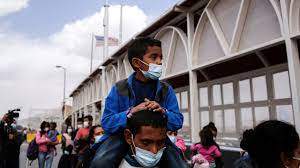Migrant Surge at U.S. Border Prompts White House Talks With Mexico, Guatemala

Senior White House officials are visiting Mexico and Guatemala this week in a bid to curtail a surge of migrants at the U.S. southern border that is raising pressure for the Biden administration to take more aggressive measures.
The high-level meetings to discuss migration and development in southern Mexico and Central America come as apprehensions at the U.S.-Mexico border are on pace to hit highs not seen in 20 years.
“Expectations were created that with President Biden’s government there would be a better treatment of migrants,” Mexican President Andrés Manuel López Obrador said during his daily press conference on Tuesday. “This has caused Central American migrants, and also from our country, to want to cross the border thinking that it is easier to do so.”
The Biden administration is now leaning more on Mexico’s authorities to turn migrants back before they can reach the U.S. border. The government of Mr. López Obrador announced last week restrictions on nonessential travel across its border with Guatemala, a measure it said was to contain the Covid-19 pandemic.
But a parade conducted on Friday by hundreds of Mexican immigration agents and National Guard officers near Mexico’s southern border showed that the enforcement efforts were focused on stopping migrants from reaching the U.S. before they come close.
Mexico’s latest enforcement campaign comes as the Biden administration agreed to supply its southern neighbor with 2.7 million doses of AstraZeneca’s Covid-19 vaccine, a request that represented a priority for the Mexican government, Foreign Minister Marcelo Ebrard said last week. “The U.S. also has common concerns with us,” he added, referring to migration.
U.S. Border Patrol agents made about 97,000 arrests of migrants crossing the border illegally in February, the most since 2019 when there was also a surge in U.S.-bound migration. Record numbers of unaccompanied minors crossing the border have posed the greatest problem for U.S. immigration authorities.
The government has apprehended an average of 523 unaccompanied minors a day over the past three weeks, according to an internal U.S. Customs and Border Protection document seen by The Wall Street Journal. At that rate, March would be a record month with some 16,000 encounters.
“It’s clear that the center of the U.S.-Mexico relationship focuses on migration and enforcement,” said Maureen Meyer, director for Mexico and Migrant Rights at the nonprofit Washington Office for Latin America. “What’s missing from this conversation is how both countries are going to ensure access to protection for people at risk.”
The Biden administration has rejected requests from reporters and photographers, including from The Wall Street Journal, to visit shelters housing unaccompanied children. Rep. Henry Cuellar (D., Texas) released photos this week from inside one such facility in Texas showing makeshift, crowded conditions.
“More has to be done to address this growing humanitarian crisis,” Mr. Cuellar said on Twitter Monday. “These migrant children need our help right now. Not later.”
Mexican authorities had encountered around 4,200 unaccompanied minors since January when the government launched last week’s border operation, which includes “public health checkpoints” at roads and airports, as well as the use of drones and night-vision equipment. Over the weekend, authorities said they found 329 Central Americans, including 114 unaccompanied minors, crammed into trucks near the border with Guatemala. Eight unaccompanied minors were among 95 people who arrived without immigration papers in the northern city of Monterrey on domestic flights from southern Mexico.
In mid-2019, the Trump administration struck a deal with Mexico—after President Donald Trump threatened to impose escalating tariffs on Mexican imports—to strengthen migration enforcement throughout Mexico. The Mexican government deployed more than 25,000 members of the National Guard in a crackdown that contributed to a sharp drop in apprehensions across the U.S.-Mexico border.
Photo: Asylum-seeking migrants from Central America, who were deported from the U.S., crossed a bridge in Ciudad Juarez, Mexico, on Monday.
PHOTO: JOSE LUIS GONZALEZ/REUTERS
Link: [https://www.wsj.com/articles/senior-u-s-officials-visit-mexico-guatemala-to-address-migrant-surge-11616514413](Migrant Surge at U.S. Border+)[Opens new window.]




